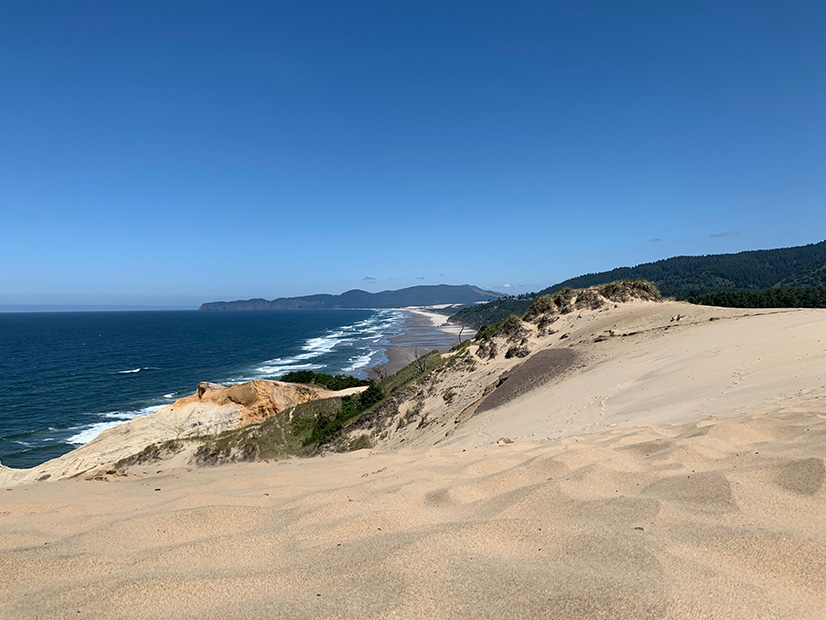
An upcoming study on the “benefits and challenges” of developing floating offshore wind (FOSW) off the coast of Oregon will explore a range of topics to help inform state lawmakers looking to produce bills to cultivate the sector.
Among the topics under examination: What impact, if any, would the state’s participation in an RTO have on facilitating development of FOSW?
During a virtual meeting to kick off the study, Jason Sierman, senior policy analyst with the Oregon Department of Energy (ODOE), said that areas of the East Coast currently seeing heavy development of OSW all have RTOs or ISOs.
“The department is interested in exploring how the nuances [of RTOs] could pose benefits and challenges to floating offshore wind coming to Oregon,” Sierman said. “Have RTOs helped spur the development of offshore wind on the East Coast? Was it primarily driven by costs or the state mandates? Or were RTOs helpful for that? Could that type of transmission structure potentially be a key for helping to spur floating offshore wind development off Oregon’s coast?”
The Oregon FOSW study is the product of House Bill 3375, passed last year to require ODOE to examine the impacts of integrating 3 GW of offshore wind into the region’s electricity system by 2030. ODOE staff are initiating the project close on the heels of completing another study weighing the benefits and risks of Oregon joining an RTO, which was submitted to the legislature late last month. (See Study Provides Ore. Lawmakers with Wide Shot on RTO Membership.)
In a similar vein to the RTO study, the FOSW report is not intended to offer policy recommendations. Instead, HB 3375 calls for ODOE to conduct a literature review and gather input from industry and regional stakeholders, various Oregon state agencies and federal entities such as the Bonneville Power Administration, the Bureau of Ocean Energy Management, the Department of Defense and energy research laboratories.
Ruchi Sadhir, ODOE associate director of strategic engagement, said the study will examine the FOSW issue from a range of perspectives, including renewable energy goals, job creation, infrastructure, transmission and ports, resilience and reliability, as well as “potential effects like impacts to ocean users and land users, impacts to the environment, public beaches, scenic byways — that sort of thing.”
“We would like the end product to be a final report to the legislature that provides neutral reporting on the literature and the range of perspectives that we’ve heard throughout this study process,” Sadhir said.
West vs. East
Oregon and the West Coast differ from the East Coast in that a sharp drop-off in the continental shelf relatively close to the coastline makes the installation of fixed-bottom OSW turbines impossible, leaving as the only option the less common floating turbine designs, which are just a “blip on the map” compared with fixed designs, Sierman said.
“There’s just a handful of [FOSW] projects out there right now, and the largest project is 50 MW, so relatively small in the grand scheme of energy projects. And the bottom line here is it’s a nascent industry,” translating into higher costs to build, Sierman said.
The West and East coasts also differ in that population centers in the former are largely situated far from the coast, leaving little existing transmission infrastructure available to interconnect large-scale OSW projects.
Sierman pointed out that most of the Pacific Northwest’s high-voltage transmission network was designed to carry energy from large hydroelectric dams in the Columbia Valley to the region’s load centers, while no large lines run out to the coast, where the largest are 230 kV.
“The big takeaway here is that as economies of scale might drive up floating offshore wind projects, there’s kind of an upper bound or a limitation currently without upgrades to existing transmission infrastructure here,” Sierman said.
For that reason, questions regarding transmission infrastructure will be one of the key topics addressed by the study. Other topics include FOSW technology, port infrastructure, siting and permitting, and “foundational” questions related to clean energy targets, equity and economic development. Another topic covers energy markets and RTOs.
Responding to a question from RTO Insider, Sadhir said the study would not attempt to capture the varying economics of placing wind turbines in different wind speed zones.
“We don’t expect to have our own technical analysis occurring,” she said. “It’s more about reviewing the literature, sharing it and giving an opportunity to get those qualitative perspectives from stakeholders on those questions as well.”
But Sadhir said the study will consider how OSW can contribute to the region’s resource adequacy, a subject she called “very topical in the energy sector.”
ODOE must submit the completed study to the legislature by Sept. 15, Sadhir noted. The department is seeking stakeholder comments by Feb. 18 and will hold another public meeting on the subject March 10.



